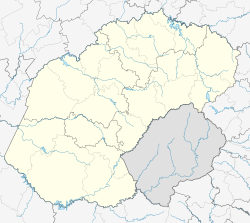Zamdela
| Sasolburg | |
|---|---|
|
|
|
| Coordinates: 26°48′51″S 27°49′43″E / 26.81417°S 27.82861°ECoordinates: 26°48′51″S 27°49′43″E / 26.81417°S 27.82861°E | |
| Country | South Africa |
| Province | Free State |
| District | Fezile Dabi |
| Municipality | Metsimaholo |
| Established | 1954 |
| Area | |
| • Total | 80.0 km2 (30.9 sq mi) |
| Population (2011) | |
| • Total | 153,038 |
| • Density | 1,900/km2 (5,000/sq mi) |
| Racial makeup (2011) | |
| • Black African | 80.8% |
| • Coloured | 0.6% |
| • Indian/Asian | 0.3% |
| • White | 18.0% |
| • Other | 0.2% |
| First languages (2011) | |
| • Sotho | 58.0% |
| • Afrikaans | 18.1% |
| • Xhosa | 8.1% |
| • Zulu | 5.7% |
| • Other | 10.1% |
| Postal code (street) | 1947 |
| PO box | 1947 |
| Area code | 016 |
| Website | http://www.metsimahololoLocalMunicipality.gov.za |
Sasolburg is a large industrial town within the Metsimaholo Local Municipality in the far north of the Free State province of South Africa. Sasolburg is further sub-divided into three areas: Sasolburg proper, Vaalpark (a more affluent cluster of suburbs located about 5 km north of the Sasolburg CBD) and Zamdela (a 'township' or area formerly reserved for Black people). Most white residents of Sasolburg speak Afrikaans as a first language, while most black people speak Sesotho as a first language. The Sasol corporation has sponsored infrastructural developments in Sasolburg, such as an Olympic size swimming pool.
The town was established in 1954 in order to provide housing and other facilities for Sasol employees. The initial installation (Sasol 1) was a pilot plant to refine oil from coal, due to the lack of petroleum reserves. The coal reserves of the country were and still are extensive. The political developments of the late 1960s and early 1970s (specifically the trade embargoes against the apartheid government) made the operation of the pilot plant a priority to the government. Plans were made for a production plant to be built in the Eastern Transvaal to produce approximately 25% of the national fuel requirements. The new town of Secunda was built to house the construction and operations staff of what became known as SASOL 2 and SASOL 3 (Secunda CTL).
Sasol One was one of the first places to be designated as a National Key Point under the National Key Points Act, which legislation protected areas so designated from “loss, damage, disruption or immobilisation (that) may prejudice the Republic”.
...
Wikipedia



